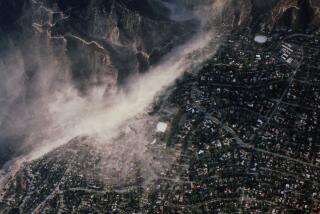Understanding a Monster
- Share via
A number of nations--including Japan, West Germany and the Soviet Union--are drilling deep into the Earth looking for signs of what triggers earthquakes. California scientists have a few more days of the same kind of work and then, for lack of funds, they will have to shut down 4,000 feet from their goal. The other countries seem to have plenty of money. Congress must keep the California project alive as well.
The global research is dedicated to learning about the evolution and dynamics of the continental lithosphere--the rigid part of the Earth’s crust and upper mantle. One portion of that project involves scientific drilling of a hole 16,000 feet into the Earth in the Cajon Pass, about two miles from the San Andreas Fault.
Earthquakes occur at depths of three to eight miles below the surface, and scientists want to look at the Earth’s structure at the three-mile depth for two reasons. They want to cross-check data that they have already collected with remote sensing equipment. They also want to leave behind the first deep seismic monitoring station. To do that, they need to drill 4,500 more feet to reach the target depth.
California scientists already find signs in the Cajon Pass that conventional theories about the fault are wrong. Some of the stress patterns run in the wrong directions. An intense grinding of tectonic plates should generate heat, but no heat is detected. Unlike what the textbooks say, the plate may act more like a box skidding on oil than teeth in gears. But because the National Science Foundation is short the $1.2 million that it will take to finish drilling the hole, the scientists are so near and yet so far. The project has gone as deep as it has only because some other projects have given up money to keep the Cajon Pass project going.
It seems to us that there is all manner of persuasive evidence to support Congress’ spending what it takes to finish the job. But maybe the best argument is the basic plea of scientists since the beginning of science. As Lee Silver of Caltech, the project’s chief geologist, says of the San Andreas Fault: “We live with this monster. We need to understand it.”
More to Read
Sign up for Essential California
The most important California stories and recommendations in your inbox every morning.
You may occasionally receive promotional content from the Los Angeles Times.










